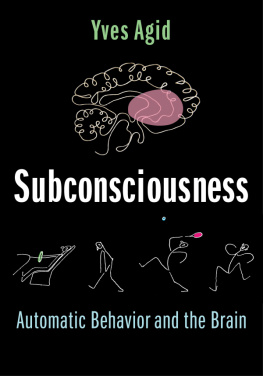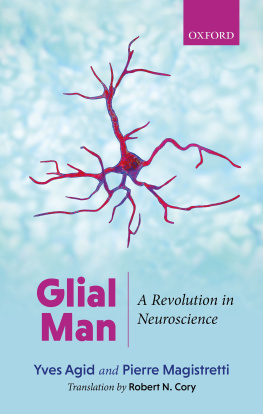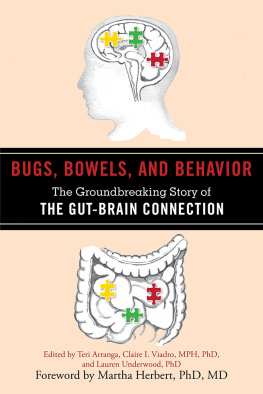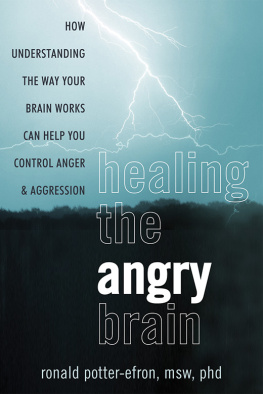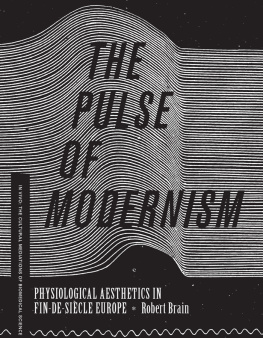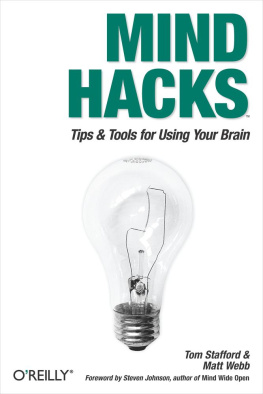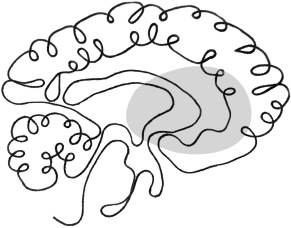Table of Contents
Subconsciousness
Yves Agid
Subconsciousness
Automatic Behavior and the Brain
Columbia University Press
New York
Columbia University Press
Publishers Since 1893
New York Chichester, West Sussex
cup.columbia.edu
Copyright 2021 Columbia University Press
All rights reserved
EISBN 978-0-231-55401-5
Library of Congress Cataloging-in-Publication Data
Names: Agid, Yves, author.
Title: Subconsciousness : automatic behavior and the brain /
Yves Agid.
Description: New York : Columbia University Press, [2021]
| Includes bibliographical references and index.
Identifiers: LCCN 2020050185 (print) | LCCN 2020050186 (ebook)
| ISBN 9780231201261 (hardback) | ISBN 9780231201278 (trade
paperback) | ISBN 9780231554015 (ebook)
Subjects: LCSH: Subconsciousness. | Consciousness.
| Human behaviorPsychological aspects. | Brain.
Classification: LCC BF315 .A36 2021 (print) | LCC BF315 (ebook)
| DDC 154.2dc23
LC record available at https://lccn.loc.gov/2020050185
LC ebook record available at https://lccn.loc.gov/2020050186
A Columbia University Press E-book.
CUP would be pleased to hear about your reading experience with this e-book at .
Cover design: Lisa Hamm
Cover image: Digital composite: (top) Science Photo Library /
Alamy Stock Photo; (bottom) Yves Agid
A Thomasine Kushner, ma trs chre amie et ma voix
And what is the use of a book, thought Alice,
without pictures or conversation?
LEWIS CARROLL, ALICES ADVENTURES IN WONDERLAND
Contents
T wo streams of my life as a neurologist joined to form this book: research in the laboratory and caring for patients in the hospital. It began when, as a young resident in neurology, my ambition was to become a good neuropsychiatrist. To achieve that mission, I knew I had to go beyond what is covered in textbooks, because they present what is known, and I wanted to prepare myself to anticipate the future. I saw that we needed to stop doing medicine in what I call the Molire way, the manner characterized by the playwright in which doctors are long on discussion but short on substance. I thought that the best way to train good neurologists was to provide the students with a high level of teaching, which entails doing excellent research that would also benefit patientsa way of thinking not in fashion at that time.
After a lengthy search, I was fortunate to find an excellent laboratory at the Collge de France in Paris, and for the next four years I devoted myself to neurobiochemistry research. When I returned to the clinic at the Salptrire Hospital after the years in the laboratory, I brought with me something unique at the time: double training as both a clinical neurologist and a neuroscience researcher. I never left the lab as I continued to see patients. Concurrently with clinical work, my research in my lab for over thirty-five years focused essentially on the physiological role of the basal ganglia, the structures deep within the cerebral hemisphere, the dark basement in the brain, as described by Kinnier Wilson, that play a major role in processing the automatic motor behavior that I was observing in the examining room and, as detailed in the following pages, form part of the concept of subconsciousness.
My intention has been not to concentrate on the most understood mental cognitive functions such as memory, language, and consciousness, but instead to reinforce the neglected concept of automatic behaviors that had been studied in the past by psychologists (e.g., Pierre Janet and William James) or philosophers (e.g., Friedrich Nietzsche) under the name subconscious, not to be confused with unconscious in the Freudian sense. My aim continues to be to explain what the subconscious is, its overlooked role in controlling 99 percent of our behavior, to trace its recently discovered anatomo-physiological substratum in the brain, with a special reference to one of the more ancient parts of the brain, the basal ganglia, and to examine what happens when it is ill.
The most famous disease resulting from damage to the basal ganglia is Parkinsons disease and in problems with controlling movements and posture.

